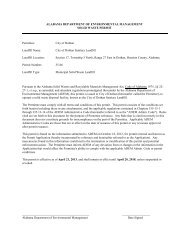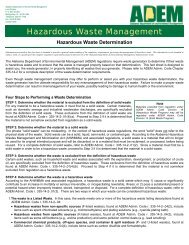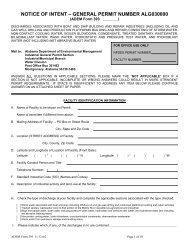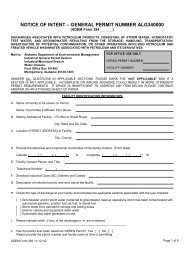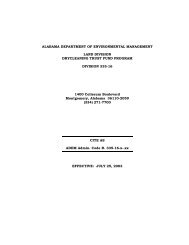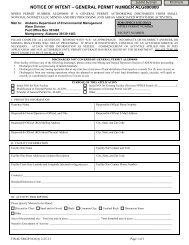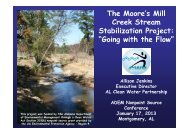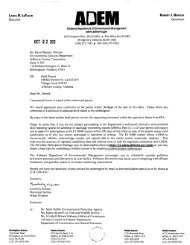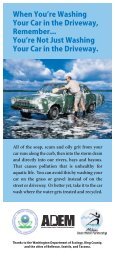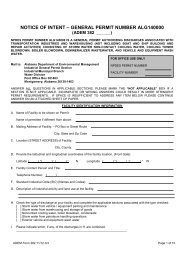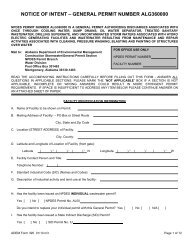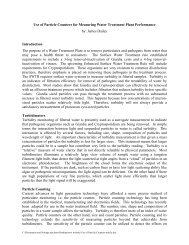drinking water branch fy2011 annual report - Alabama Department ...
drinking water branch fy2011 annual report - Alabama Department ...
drinking water branch fy2011 annual report - Alabama Department ...
You also want an ePaper? Increase the reach of your titles
YUMPU automatically turns print PDFs into web optimized ePapers that Google loves.
268 systems monitored for Lead and Copper in FY2011. Two <strong>water</strong> systems exceeded the<br />
copper action level and two <strong>water</strong> systems exceeded the lead action level in FY2011. Water<br />
systems that exceed an action level must submit a corrosion control plan, conduct source <strong>water</strong><br />
and <strong>water</strong> quality parameter monitoring, and return to six month monitoring. In addition,<br />
systems that exceed the lead action level must also provide their customers with lead education<br />
materials. Approximately half of these <strong>water</strong> systems had provided the required proof that they<br />
notified their customers of the sample results by the end of FY2011. A complete <strong>report</strong> of lead<br />
and copper compliance data for calendar year 2011 will be included in the 2011 <strong>annual</strong><br />
violations <strong>report</strong> which will be produced in May or June 2012.<br />
Disinfection Byproduct Monitoring and Compliance<br />
367 community and NTNC <strong>water</strong> systems were required to monitor for disinfection byproducts.<br />
DBPs include total trihalomethanes (TTHM) and haloacetic acids (HAA5). Listed below are the<br />
systems that incurred MCL violations.<br />
TABLE 4<br />
DBP VIOLATIONS<br />
System Contaminant Source<br />
CWM Water Authority HAA5 Purchase Surface<br />
Guin Water and Sewer Board HAA5 Surface<br />
Ranburne Water and Sewer <strong>Department</strong> HAA5 Purchase Surface<br />
Swearingen Water System HAA5 Purchase Surface<br />
Wedowee Water, Sewer and Gas Board HAA5 Surface<br />
The <strong>Department</strong> has issued orders against three of the above systems. These three systems<br />
received more than one violation and were not able return to compliance, necessitating an order.<br />
These orders require the system to return to compliance within a specified amount of time. No<br />
<strong>water</strong> systems incurred monitoring violations for disinfection byproducts during FY2011.<br />
All systems with a surface source or a source that is classified as ground<strong>water</strong> under the<br />
influence of surface <strong>water</strong> (GWUDI) are required to monitor for total organic carbon (TOC).<br />
These systems were required to collect raw <strong>water</strong> and a combined filtered <strong>water</strong> sample each<br />
month. TOC results from each plant are evaluated to determine if the plant is meeting TOC<br />
removal requirements or to determine if monitoring could be reduced to quarterly for TOCs. No<br />
<strong>water</strong> systems incurred treatment technique violations for failure to meet TOC removal<br />
requirements.<br />
Laboratory Certification Program<br />
<strong>Department</strong> regulations require an <strong>annual</strong> fee for recertification of <strong>drinking</strong> <strong>water</strong> laboratories.<br />
The fee for certification varied from $170.00 for bacteriological certification to a maximum of<br />
$680.00 for chemical laboratory certification. All chemical and bacteriological analyses of <strong>water</strong><br />
samples required by the State must be analyzed at a laboratory certified by ADEM.<br />
13



